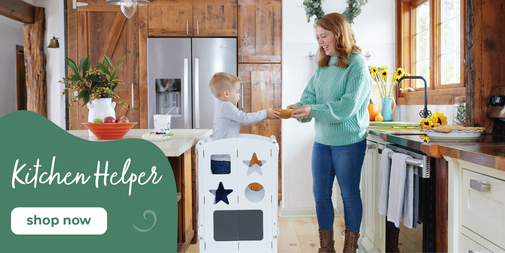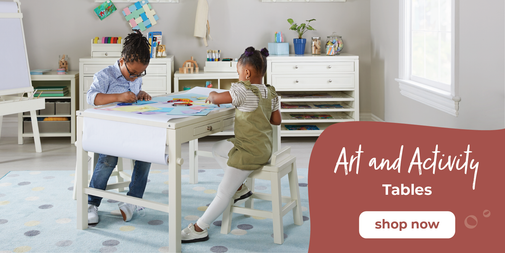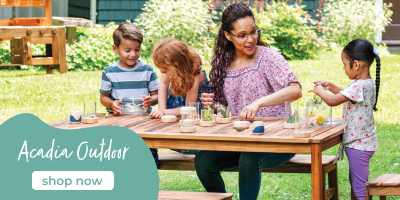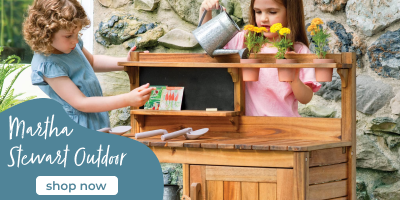13 Expert Ideas for Designing a Small Preschool Space
A small preschool classroom can be just as magical - and just as effective in supporting early childhood development - as a larger one. In fact, with a smaller space, every design choice carries even more impact.
Thoughtful planning and intentional design can transform even the coziest classroom into a dynamic environment that inspires young minds to engage, explore and grow.
Think about it - Why can’t every space, every element, and every piece of furniture in a child’s environment contribute towards their development? Why should utilitarian elements be just functional, rather than something that adds meaning to a child’s learning journey?
Whether a space is large or small, every aspect of a preschool classroom has the potential to spark curiosity, creativity, and exploration. There’s so much we can do—even in the smallest spaces—to make learning more engaging and meaningful.
At their core, preschools should be more than just places to learn—they should be spaces that:
- Encourage independence by allowing children to make choices and explore freely.
- Foster creativity through open-ended play and engaging materials.
- Inspire exploration by creating an environment that sparks curiosity.
- Support hands-on learning with interactive and sensory-rich experiences.
- Promote comfort and security so children feel safe and supported.
Whether it’s through furniture that promotes cognitive and physical play or designs that invite them to interact with their environment, every inch of the space matters. With a little creativity and smart space arrangement, you can create a well-planned environment that’s both functional and inspiring for kids.
Here are 13 practical ideas along with expert tips for designing a small preschool classroom that supports children's growth. From smart storage to well-defined areas, we’ll show you how small spaces can make a big impact on young learners!
1. Make the Entrance Inviting and Engaging
The first moment a child steps into a preschool sets the tone for their experience. Children should be welcomed with something that speaks to them. Whether the preschool is small or big, the entrance should spark excitement, curiosity, and a sense of belonging.
- Prioritize Child-Centric Design: Avoid filling the entrance with functional storage or purely practical elements. Instead, let the first thing children see be something engaging— a playful visual, a cozy nook, or an element that immediately draws them in.
- Encourage Interaction from the Start: Incorporate interactive elements that invite children to engage the moment they step inside. A child-height mirror can spark self-recognition, while sensory walls, stepping-stones, or a small balance path encourage movement and playful exploration.
- Set a Warm and Welcoming Tone: Use soft colors, cheerful graphics, or a display of children's artwork to make the space feel inviting. A thoughtfully designed entrance helps children feel comfortable and excited to begin their day.
2. Incorporate Key Learning Zones for a Balanced Classroom
Even in a compact preschool classroom, it’s essential to include diverse play and learning experiences that support different developmental needs. Well-defined areas allow children to explore, create, and build essential skills without overwhelming the space.
- Block Building Area: Block play sparks creativity, problem-solving, and collaboration, making it an essential part of any preschool. Whether stacking wooden blocks, connecting magnetic tiles, or constructing with interlocking bricks, children explore shapes, balance, and structure in an engaging way. A well-placed rug helps define the space while providing a soft, comfortable surface for building.
- Integrate STEM play: STEM toys introduce early math, engineering, and science concepts through interactive play. Thoughtfully designed toy sets encourage problem-solving and creativity without taking up too much space.
- Gross & Fine Motor Play Area: A well-designed space should encourage both big and small movements—jumping, balancing, and climbing, as well as activities that refine hand-eye coordination. Sensory play on different levels, such as those found in Guidecraft’s Sensory System, provides opportunities to develop coordination and precision through play and movement.
Bonus Tip: Position the block-building area toward the back of the classroom, as children often scatter materials while playing. To keep the space contained and organized, surround it on three sides with functional elements like storage shelves or bookcases.
3. Storage Solutions That Support Learning and Independence
Storage does more than organize - it creates an environment that nurtures independence, encourages exploration, and supports child-led learning. Thoughtfully placed storage solutions define learning zones while keeping materials accessible, empowering kids to make choices and take ownership of their learning.
- Encourage Independence: Low storage units allow children to access and put away their materials on their own, promoting responsibility and confidence.
- Define Learning Zones with Purposeful Storage: Strategically placed shelves, book bins, and cubbies can help structure different areas like reading corners, play spaces, and hands-on activity zones. Open-back or acrylic-backed shelves let light flow through, keeping the space bright and open while reducing visual clutter.
- Maximize Storage Without Bulk: Guidecraft’s storage solutions, like the EdQ Book and Bin Browser, provide a balance of open and hidden storage, ensuring easy access while maintaining a tidy classroom.
4. Make Room for Artistic Expression
A dedicated space for art and creativity inspires children to explore their imagination. Encourage expression by providing a small, dedicated space for painting, drawing, or crafting.
- Set Up an Adaptable Art Station: Guidecraft’s Kids' Desk to Easel Art Cart easily transforms from a flat desk to an angled drawing station with a double-sided easel, chalkboard, and paper roll, providing a versatile space for young artists.
- Opt for Built-in Storage: Choose art stations like the Kids’ Deluxe Art Center, that include storage compartments to keep materials organized and accessible, ensuring a streamlined and efficient space small preschool design.
- Invest in Movable Units: Art carts like the Kids' Art Activity Cart can be moved and positioned based on need, again making it suitable for small preschool spaces.
5. Turn a Tiny Corner into a Cozy Reading Nook
A reading nook is a must-have in any preschool, even in small spaces. You can transform a corner of the room into a cozy, inviting area with furniture that combines seating and storage.
- Create a Cozy Atmosphere: Guidecraft’s EdQ Reading Nook with Storage features built-in shelves beneath seats - perfect for storing books and plush toys. Soft cushions and child-sized seating make the space inviting and comfortable.
- Encourage Independent Reading: A reading nook provides a cozy space for kids to explore books, fostering a love for reading and promoting self-reliance.
- Go for Space-Saving Solutions: Opt for vertical storage solutions like the EdQ Rotating Book Display that keep books organized and accessible without taking up too much floor space. A compact, spinning design allows children to easily browse and select their favorites.
6. Make Space for Everyday Essentials
Even when designing a small preschool, essential areas like a kitchen, changing station, and resting spots are a must. The key is to keep them functional without letting them take over the space. A little creativity goes a long way in making these areas blend seamlessly into the environment.
- Create a Compact Kitchen Corner: A small snack station with accessible storage keeps meal prep simple and organized without occupying space.
- Keep Diaper Changes Hassle-Free: A fold-down or wall-mounted changing table saves space while making diaper changes quick and easy.
- Make Room for Naps: Stackable cots or compact cribs provide a cozy resting spot and can be tucked away when not in use.
7. Mirrors & Windows Play a Key Role in Small Spaces
Can every part of the classroom environment contribute to a child's growth? Definitely! Every design and interior element play a role in shaping their learning experience. Every part of a preschool classroom should be more than just functional; it should spark curiosity, imagination, and engagement.
Mirrors Create Endless Opportunities for Discovery
Placed at different heights, mirrors invite children to see themselves and their surroundings in new ways.
- At eye level, they become interactive tools for self-recognition, dramatic play, and sensory exploration.
- Higher mirrors give babies and toddlers a new perspective when held up by a teacher, expanding their view of the world.
- Mirrors also reflect light, brightening up small spaces and making them feel more open.
Windows Open a World Beyond the Classroom
Large windows do more than bring in light—they create a connection between indoors and outdoors.
- Full-height windows make the space feel bigger and provide a sense of openness.
- They encourage children to observe the world beyond, fostering curiosity and an appreciation for nature.
- If windows are small, placing mirrors around them can amplify their effect, bringing in more light and depth.
Pro Tip- When windows aren’t an option, a creative alternative is using LED light panels with plants to bring in a sense of nature and calm. This small addition can make the space feel more alive and engaging.
8. Invest in Flexible, Multifunctional Furniture
When space is limited, the right furniture can make all the difference, helping your classroom stay flexible, functional, and fun. Choosing adaptable, space-saving furniture helps create a classroom that’s always smartly organized, welcoming, and ready for new adventures.
- Maximize Space: Activity tables with built-in storage, like Guidecraft’s Martha Stewart Kids' Art Table and Stool Set, keep supplies organized without adding extra bulk.
- Reduce Clutter: Seating with hidden storage compartments keeps everything in place, making clean-up time a breeze.
- Ensure Seamless Transitions: Movable furniture like the Mobile Book Organizer makes it easy to switch between activities—foldable tables open up space, stackable chairs allow for quick setup, and portable feeding chairs ensure a designated mealtime area without occupying up permanent space.
9. Display Children's Work Without Taking Up Space
A classroom should celebrate its students! Displaying children’s artwork builds confidence and helps create a personalized and inspiring atmosphere. Display systems are also a great way to showcase creativity without covering valuable floor or table space.
- Utilize Wall Space: Wall-mounted display panels showcase creativity while keeping surfaces clear.
- Make Art Displays Simple and Dynamic: Rotating displays like magnetic boards or clip systems make updating artwork simple and organized.
- Keep It at Eye Level: Lower displays ensure children can easily admire and engage with their work.
10. Create a Mini Sensory Zone
Sensory play is an important part of early childhood development, and you don’t need a huge space to make it happen.
- Compact Sensory Tables: Guidecraft’s Sensory System offers interactive play with a multi-purpose bottom shelf to store sensory materials. Another simple way to create a sensory experience is by setting up an LED Tabletop Lightbox, which creates a captivating space for color exploration, light play, and hands-on discovery.
- Maximize Corners: Transform an unused space into a sensory station, offering tactile experiences.
- Incorporate Sensory Toys: Sensory toys, like textured balls or shape sorters, help children develop motor skills, improve focus, and provide calming, hands-on experiences.
11. Design Play Zones That Do More
When designing a small preschool classroom, it’s essential to make every corner count—creating spaces that inspire play, learning, and imagination. Thoughtfully designed play areas do more than entertain; they foster creativity, collaboration, and cognitive growth.
- Spark Imagination with Play Furniture: Guidecraft’s Pretend Play Tents are perfect for creating immersive worlds where children can build social skills, role-play, and explore their imagination.
- Foster Teamwork: Create spaces where children can collaborate on creative activities, promoting teamwork and communication through shared play experiences.
- Support Cognitive Growth: Incorporate flexible play zones that encourage children to problem-solve, think critically, and explore new ideas while having fun.
12. Integrate Nature for a Calming Atmosphere
Nature can help make small spaces feel larger and more peaceful. Even in a small preschool set-up, adding natural elements can make a big impact on the learning environment.
- Bring in Greenery: Small potted plants or a vertical garden introduce fresh air and a sense of calm.
- Use Natural Materials: Wooden furniture, woven baskets, and nature-inspired decor create a warm, inviting space.
- Let in Natural Light: Maximize natural light by keeping windows clear or using light, airy curtains, which can create a bright and open atmosphere, fostering a peaceful learning environment.
13. Design Areas for Both Quiet and Social Play
A well-balanced classroom includes spaces for both quiet, reflective activities and social, interactive play. Create designated spaces to ensure this balance, promoting cognitive and emotional development.
- Create a Cozy Retreat: A tent-like nook offers children a quiet space to relax, unwind, and recharge. Soft cushions, plush rugs, and dim lighting can make it even more inviting, providing a sense of security and comfort in a busy classroom.
- Balance Stimulation Levels: Position quiet areas away from high-energy play zones to create a calming environment free from distractions.
- Offer Solo Play Options: Simple puzzles, sensory bins, or independent reading corners provide opportunities for children to engage in self-directed learning.
Now that we've covered the essential design ideas, let’s look at a few expert tips that will ensure your small preschool space supports children’s growth while being as functional as it is inviting.
Expert Tips to Keep in Mind While Designing Your Small Preschool Space
Designing a preschool space goes beyond furniture choices—it’s about creating an environment that nurtures all aspects of a child's growth. Here are some essential considerations for ensuring a balanced and enriching learning space:
- Choose GreenGuard Gold Certified Furniture
Opt for certified furniture to ensure better indoor air quality. GreenGuard Gold-certified pieces have low emissions, keeping children safe from harmful chemicals while creating a healthier learning space.
- Ensure Furniture is Child-Safe with Soft Edges
Rounded corners and soft edges reduce the risk of bumps and injuries, making the environment safer for active preschoolers. Child-friendly furniture allows kids to explore freely without unnecessary hazards.
- Use A Well-Balanced Color Scheme
Colors influence children's emotions and cognitive development. Bright hues inspire creativity and energy, while calming tones promote focus and relaxation. A well-balanced color scheme enhances the learning experience.
- Reduce Distractions with Sound-Absorbing Materials
Preschools can get noisy, making it hard for kids to focus. Soft furnishings like rugs, curtains, and acoustic panels help absorb sound, creating a quieter, more peaceful learning environment. Cozy materials also make the space feel warm and inviting.
- Implement Easy-to-Clean Surfaces
Messes are part of preschool life, so choosing easy-to-maintain materials is a must. Opt for washable cushions and stain-resistant surfaces to keep the space hygienic with minimal effort.
Guidecraft’s wooden furniture is designed for durability and easy cleaning, featuring smooth surfaces that wipe down effortlessly, making cleanup quick and hassle-free.
- Use Interactive, Dynamic Decor
Make the environment engaging with decor that evolves with children's interests. Bulletin boards, magnetic walls, and rotating displays keep learning materials fresh and relevant while adding a personalized touch to the space.
- Keep Transitions Smooth with Clearly Defined Areas
A well-organized space makes daily routines easier for children. Use rugs, wall decor, or different colors to mark activity zones. Label bins and shelves with pictures to encourage independence and maintain order.
Bringing It All Together
Designing a small preschool space can be a rewarding challenge when approached with creativity and smart solutions. By focusing on multifunctional furniture, efficient storage, and flexible layouts, you can create a thoughtfully designed space that’s both inspiring and practical.
Ready to design your preschool classroom? Explore Guidecraft’s Classroom Furniture for a wide variety of furnishings and storage solutions designed to make the most of your space without compromising on quality or functionality.














